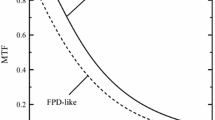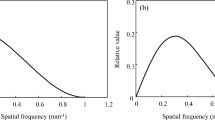Abstract
The point spread function (PSF) method is currently the one predominantly used to determine the modulation transfer function (MTF) of an X-ray CT system. However, the image examined with the PSF method must have a very high contrast-to-noise ratio (CNR); it must also be reconstructed with a fine pixel pitch using a zooming reconstruction. Therefore, the PSF method is often inappropriate for describing the MTF of clinical operating conditions when image linearity is not guaranteed. The edge spread function (ESF) method requires no zooming reconstruction, but its susceptibility to image noise is no better than that of the PSF method. We describe a technique for rendering the ESF method robust to image noise. We smooth out the noisy ESF through multiple stages of filtering. Invariably, the line spread function (LSF) obtained from the smoothed ESF is blurred, and the MTF obtained from the LSF is incorrect. However, because the filtering that has been applied is known, much of the LSF blurring can be corrected. An estimate of the true LSF is obtainable from the blurred LSF, assuming that the true LSF is not very different from either a Gaussian or a composite of multiple Gaussians. For an image reconstructed with a kernel for soft-tissue imaging, the MTF obtained by our method is sufficiently consistent with the theoretical MTF, even when the CNR is as low as 2.













Similar content being viewed by others
References
Metz C, Doi K. Transfer function analysis of radiographic imaging systems. Phys Med Biol. 1994;24:1079–106.
Kalura M, Wittram C, Maher M, Sharma A, Avinash G, Karau K, et al. Can noise reduction filters improve low-radiation-dose chest images? Pilot study. Radiology. 2003;228:257–64.
Okumura M, Ota T, Tsukagoshi S, Katada K. New method of evaluating edge-preserving adaptive filters for computed tomography (CT): digital phantom method. Jpn J Radiol Technol. 2006;62:971–8.
Wessling J, Esseling R, Raupach R, Fockenberg S, Osada N, Gerss J, et al. The effect of dose reduction and feasibility of edge-preserving noise reduction on the detection of liver lesions using MSCT. Eur Radiol. 2007;17:1885–91.
Judy P. The line spread function and modulation transfer function of a computed tomographic scanner. Med Phys. 1976;3:233–6.
Boone J. Determination of the presampled MTF in computed tomography. Med Phys. 2001;28:356–60.
Fujita H, Tsai D, Itho T, Doi K, Morishita J, Ueda K, et al. A simple method for determining the modulation transfer function in digital radiography. IEEE Trans Med Imaging. 1992;11:34–9.
Peters T, Lewitt R. Computed tomography with fan beam geometry. J Comput Assist Tomogr. 1977;1:429–36.
Kak A, Slaney M. Principles of computed tomographic imaging. Philadelphia: SIAM Press; 2001. pp. 77–86.
Nickoloff E, Riley R. A simplified approach for modulation transfer function determinations in computed tomography. Med Phys. 1976;12:437–41.
Cunningham I, Fenster A. A method for modulation transfer function determination from edge profiles with correction for finite-element differentiation. Med Phys. 1987;14:533–7.
Buhr E, Günther-Kohfahl S, Neitzel U. Accuracy of a simple method for deriving the presampled modulation transfer function of a digital radiographic system from an edge image. Med Phys. 2003;30:2323–31.
Glover G, Eisner R. Theoretical resolution of computer tomography systems. J Comput Assist Tomogr. 1979;3:85–91.
Durand E, Rüegsegger P. High-contrast resolution of CT images for bone structure analysis. Med Phys. 1992;19:569–73.
Kijewski M, Judy P. The noise power spectrum of CT images. Phys Med Biol. 1987;32:565–75.
Bracewell R. The Fourier transform and its application, 3rd ed. New York: McGraw-Hill; 1999. pp. 434–5.
Bracewell R. The Fourier transform and its application, 3rd ed. New York: McGraw-Hill; 1999. pp. 186–90.
Author information
Authors and Affiliations
Corresponding author
Appendices
Appendix 1: Theoretical MTF
Factors affecting the MTF are listed as follows, along with some notes:
-
1.
A pulsed X-ray is used to generate projection data. We can therefore ignore blurring caused by the motion of the X-ray beam during sampling.
-
2.
The pixel size is irrelevant to our MTF because our back-projection is performed assuming that each pixel is an arealess point.
-
3.
The location of evaluation. Although our edges are located somewhat off-center, we analyze the MTF at the isocenter for simplicity. The greatest cause of the positional and directional dependence of the MTF is the X-ray beam motion, which is negligible for our case. The secondary cause is that an off-center object sees the focus at an angle, and that the effective focal size differs from that of the isocenter. Nevertheless, our edges are not far from the isocenter, and the angle effect is only minor.
-
4.
The X-ray focus width. The spatial distribution of the X-ray beam attributable to its finite focus size is rectangular. We assign WS to the projected focus width at the isocenter.
-
5.
The detector element aperture width. Similarly, the spatial response attributable to the detector aperture is a rectangular function. We assign WD to the projected detector width at the isocenter.
-
6.
The ray sampling pitch. Its projected value at the isocenter is also WD.
-
7.
The frequency response of the image reconstruction kernel is denoted by K(f). The soft kernel we used is a Shepp–Logan filter; its K(f) is as follows, where \( f_{N} = {\raise0.7ex\hbox{$1$} \!\mathord{\left/ {\vphantom {1 {2W_{\text{D}} }}}\right.\kern-\nulldelimiterspace} \!\lower0.7ex\hbox{${2W_{\text{D}} }$}} \) is the Nyquist frequency:
$$ K\left( f \right) = \left\{ {\begin{array}{*{20}c} {\sin \left( {\pi fW_{\text{D}} } \right)} & { - f_{N} < f < f_{N} } \\ 0 & {\text{elsewhere}} \\ \end{array} } \right. $$(12)The K(f) of the hard kernel cannot be expressed in a clean form because it is a numerical binary file of an existing CT.
-
8.
The linear interpolation for back-projection. Its frequency response I(f) is well known.
$$ I\left( f \right) = \left( {\frac{{\sin \left( {\pi fW_{\text{D}} } \right)}}{{\pi fW_{\text{D}} }}} \right)^{2} $$(13) -
9.
Quarter offset. We adopted this arrangement for our projection data generation. This will simplify the analysis of the MTF later.
The MTF of CT has two parts. One is the frequency response of the X-ray measurement. The other is the frequency response of the image reconstruction processes. The MTF is their product.
The presampling frequency response of X-ray measurement is expressed by the aperture transfer function (ATF), which is the product of the frequency response of the detector aperture and the focal size [13]:
Actually, the X-ray measurement is done with the sampling pitch W D, and the sampled version of the ATF is the superposition of replications separated by the frequency pitch 2f N [14]. The following ATF′ is the frequency response of the discrete X-ray measurement:
However, because of the quarter offset alignment, the first order (j = ±1) of replications vanishes when projection data for one full rotation are used [8]. Unless our X-ray focus and the detector’s aperture are too small, the aliasing from higher-order replications is negligible. Then, ATF′ reverts to the ATF:
We denote the frequency response of the image reconstruction algorithm by MTFalg; its basic form is written as follows:
Two modifications must be applied to the above MTFalg. First, although K(f) is defined only within ± f N , the image reconstruction is performed in a discrete form; its pitch is the ray-sampling pitch. Therefore, the discretized version of K(f) is accompanied by its replications separated by the frequency pitch 2f N [15]. Second, the filtered discrete projection data are interpolated before backprojection. We must consider the frequency response I(f) of the interpolation. Then, the correct form of MTFalg is expected to be as follows:
The I(f) rapidly reduces to zero at high frequencies, thereby eliminating the need to consider replications of K(f) of higher order than the first replication. Therefore, the following is a reasonable approximation; here, we ignored negative frequencies:
Consolidating Eqs. 13, 14, 16, and 20, we obtain Eq. 21 as an approximate theoretical MTF.
Appendix 2: Gaussian correction
The variance V of a continuous profile f(x) is defined as follows:
In our rebinnings, the pitches of both input and output are sufficiently smaller than the bin size. Therefore, the rebinning can be approximated well by using a convolution of a continuous rectangular function with a width corresponding to the bin size. Without calculation, the variances V w1 and V w2 of rectangular functions of widths w 1 and w 2 are well known:
The smoothing is a convolution. Although the data pitch of the ESF-C is not perfectly uniform, it is, on average, the rebinning pitch b 2. Therefore, the pitch of the convolution kernel (s 1, s 2, s 3) is b 2. Its variance V r is calculable according to the definition of the variance in discrete form:
For our case (s 1, s 2, s 3) = (1/4,1/2,1/4), we obtain
The linear interpolation of the data with pitch b 2 is well known to be the same as the convolution by a triangular function that has a bottom width of 2b 2. The variance V LI of such a triangular function is also known to be
Based on the additive nature of variance [16], we take the summation of all variances described above and designate it as V blur. The V blur represents the overall blurring caused by all data processes. The factor 2 for V r is used because we apply smoothing twice.
Consequently, the true variance of the unblurred LSF V t must be as shown below. Here, \( V_{{{\text{LSF}}_{\text{b}} }} \) is the variance of the LSFb:
For the soft-kernel case, we assume that the true LSF is not very different from a Gaussian function [10]. The LSFb is guaranteed to be more like a Gaussian, excluding distortion because of noise, because smoothing procedures engender a Gaussian profile according to the central-limit theorem [17]. A hypothetical Gaussian function for the true LSF can be written as Eq. 32, where \( \left\langle {x_{{{\text{LSF}}_{\text{b}} }} } \right\rangle \) denotes the center of gravity of LSFb. We are not concerned with the amplitude.
A blurred version G B, which has variance V LSFb, is
To recover G H from G B, we must multiply G B by the correction factor G C:
This G C is a reasonable correction function for recovering the true LSF from LSFb if the true LSF does not differ greatly from a Gaussian function. This engenders Eq. 6 in the main text.
When the image is reconstructed using a hard edge-enhancing-type kernel, the assumption of a Gaussian-like LSF does not hold at all. Still, as long as the LSF is modeled using a linear superposition of multiple component functions, the difference between the variance of each component function before and after the blurring is V blur. This leads to Eq. 11 in the main text.
About this article
Cite this article
Mori, I., Machida, Y. Deriving the modulation transfer function of CT from extremely noisy edge profiles. Radiol Phys Technol 2, 22–32 (2009). https://doi.org/10.1007/s12194-008-0039-9
Received:
Revised:
Accepted:
Published:
Issue Date:
DOI: https://doi.org/10.1007/s12194-008-0039-9




